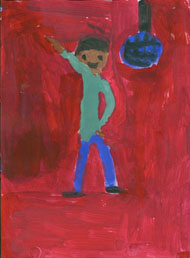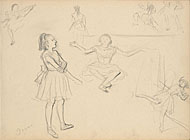Grades/Level: Upper Elementary (3–5) |
|
|||||||||||||||||||||||||||||||||||||||||||||||||||||
Lesson Overview |
|
|||||||||||||||||||||||||||||||||||||||||||||||||||||
Students will observe dance movements depicted in a drawing and a painting. Partners will use simple lines to draw their partner's movements and paint dance costumes on the figures using various brushstrokes. Students will write a persuasive speech to the school superintendent explaining why they believe dance should be a regular part of the curriculum. They will then model dance movements for classmates in teams of four and recite their persuasive speech to the class. |
||||||||||||||||||||||||||||||||||||||||||||||||||||||
Learning Objectives |
||||||||||||||||||||||||||||||||||||||||||||||||||||||
Students will be able to: |
||||||||||||||||||||||||||||||||||||||||||||||||||||||
Materials |
||||||||||||||||||||||||||||||||||||||||||||||||||||||
• Reproduction of Ballet Dancers Rehearsing by Edgar Germain Hilaire Degas |
||||||||||||||||||||||||||||||||||||||||||||||||||||||
|
||||||||||||||||||||||||||||||||||||||||||||||||||||||
Lesson Steps |
||||||||||||||||||||||||||||||||||||||||||||||||||||||
Part 1: Sketching Dancers
2. Discuss the movement of the figures in the drawing and chart students' responses to the following questions:
Point out that the artist depicts movement by drawing wavy lines in the dancers' skirts. 3. Ask students what kinds of dancing they enjoy. Then call on a student volunteer to pose as if dancing. Model how to create a quick gesture sketch of the student. For instructions on creating a gesture sketch, view the art activity "Create a Gesture Sketch." 4. Have students work in pairs, posing for each other as if doing their favorite dance. The observing partner will do simple gesture sketches (on 8 1/2 x 11–inch copy paper) to depict how their partner's arms, legs, and feet move. Part 2: Painting Movement 1. Display a reproduction of Dance before a Fountain by Nicolas Lancret. Ask questions to guide discussion:
Point out to students that social dancing, like the kind depicted in the painting, was very popular in the 18th century. In fact, learning basic dance steps was an important part of the training that the middle class and aristocracy received while learning appropriate behavior in society. Ask students how and where they learned the dance that they sketched in Part 1. 2. Discuss the movement of the figures in the painting and chart students' responses to the following questions:
Point out to students how the white dress worn by the woman in the center of the painting looks as if it is moving. Also point out that the pink-and-blue cape worn by the man with the pink hat shows movement. The artist is able to depict movement by painting wavy lines in the fabric. 3. Return to the students' gesture sketches. Have students choose one of sketches that they think best represents their favorite dance form. Have them use the gesture sketch as a guide for a new drawing. Distribute 9 x 12–inch drawing paper. Model how to use rectangles instead of lines for the figure's legs and arms. Allow students time to draw on the drawing paper. Have them add a face and a costume to their figure. Instruct them to consider what types of dance costumes are appropriate for the type of dance they are depicting (e.g., fancy gown for ballroom dancing, t-shirt and jeans for break dancing). 4. Distribute watercolor paints, brushes, and cups of water. Tell students to use the watercolors to paint the figures and costumes on their drawings. Instruct students to use sweeping brushstrokes to create wavy lines to show the movement of clothing or hair. 5. Students will paint a background that shows where the scene is taking place (at a party, on stage, etc.). Encourage lively strokes with lines showing movement. Part 3: Persuading People to Dance 1. Ask students if they like to dance. Remind them that learning basic dance steps was an important part of training received by the middle class and aristocracy in 18th-century France. Tell students that dance is not often taught in schools today, and ask them if they would like to learn how to dance in school and why? 2. Teach students the persuasive writing format. Tell students that the goal is to get the reader to agree with their opinion about something. Students should be able to prove that their opinion really matters. For this assignment, students will write a persuasive speech explaining to the school superintendent why dance should be a regular part of the curriculum. 3. Share instructions on pre-writing. Tell students to list reasons for their opinions about the topic. They should be informed with facts and/or examples to support their points. Have students discuss with others their opinions as well as opposing opinions. Tell them to draw a two-column chart (t-chart) with the headings "Pros" and "Cons" and fill in the chart. 4. Teach students about the different ways to write leads for persuasive writing, giving some examples. You can discuss the following methods that use:
5. Pass out and model the use of the "Persuasive Writing Outline" handout. Be sure that students write their position statement in positive terms. Have them also list their supporting reasons and details so that the strongest reason is either first or last. 6. Find and share examples of persuasive essays, both powerful and weak, with students. Discuss the strengths and weaknesses of each, and identify language that was powerful. 7. Have students write the first draft of their speech. 8. Then pass out the "Persuasive Writing Checklist." Have students use it to be sure they include all components in their drafts. Students will either peer-edit or self-edit, and revise their writing by using the checklist. Part 4: Persuading and Dancing 1. Review with students your expectations for oral presentations, including some tips for overcoming nervousness, such as the following:
2. Tell students that they will be working in small groups of four to teach each other a dance move of their choice. Have them come to class with music to accompany the dance move. Arrange a space large enough for each team to work together. 3. Allow students to teach each other the dance moves in their small groups. 4. End the lesson with students' oral presentations of their persuasive speeches. |
|
|||||||||||||||||||||||||||||||||||||||||||||||||||||
Assessment |
||||||||||||||||||||||||||||||||||||||||||||||||||||||
Students will be assessed on: |
||||||||||||||||||||||||||||||||||||||||||||||||||||||
Extensions |
||||||||||||||||||||||||||||||||||||||||||||||||||||||
• Social Studies: As part of a unit on immigration, students can research dances from their country of origin and create paintings that reflect traditional costumes. Students can incorporate their paintings onto a presentation board about their country, their family history, and family tree, including interviews with ancestors and artifacts. |
||||||||||||||||||||||||||||||||||||||||||||||||||||||
Standards Addressed |
||||||||||||||||||||||||||||||||||||||||||||||||||||||
Common Core Standards for English Language Arts |
|
|||||||||||||||||||||||||||||||||||||||||||||||||||||






